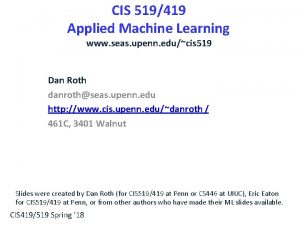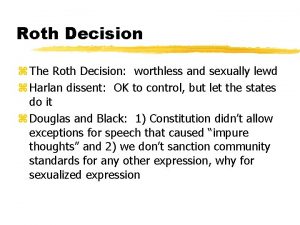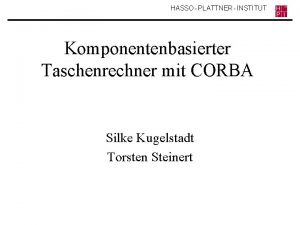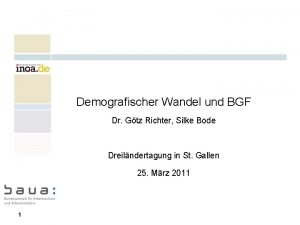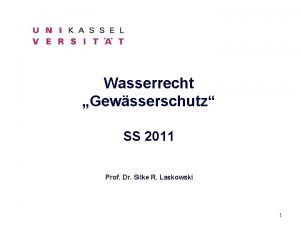Dr Silke Roth Silke Roth srothsoton ac uk












- Slides: 12

Dr Silke Roth @Silke. Roth sroth@soton. ac. uk Department of Sociology, Social Policy and Criminology Collective Action and Social Change Guest Lecture 17/11/14

Overview • Part 1 – Social Movements and Protest • Part 2 – Digital Humanitarianism

Part 1: Social Movement “A social movement is a conscious, collective, organized attempt to bring about or resist large-scale change in the social order by noninstitutionalized means. ” Cohen and Kennedy (2007) Global Sociology, p. 437

Some Causes of Social Movements • (Perception of) Social Inequality and Change • Political Opportunity – Regime Crises, Decline in Repression • • • Prior Organisation and Collective Identity Cross-cutting solidarities Leadership Availability Communication Networks Belief in Necessity and Effectiveness Frame Alignment and Alignment Skill Lofland (1996) Social Movement Organizations. Guide to Research on Insurgent Realities

Outcomes of Social Movements • Political and Policy Outcomes • Mobilization • Cultural Outcomes

Tarrow (1994) Power in Movement Repertoires in Contention (Conventional, Disruptive, Violent) – – Protests, Strikes, Sit-Ins, Blocking Traffic Boycotts, withholding rents or tax Petitions, Lobbying Education (Leaflets, Teach-Ins, Ads) Repertoires of Organisational Form: – Small grassroots organisation – Large mass membership organisation – Coalitions and networks

Electronic Repertoires of Contention • Conventional Electronic Contention – Representation, information distribution, research, artistic production, fundraising, lobbying, mobilization • Disruptive Electronic Contention – Email floods, form floods, fax bombs, viruses, worms, trojan horses, data theft or destruction, site alteration or redirection, denial of service, virtual sit-ins • Violent Electronic Contention (‘cyberterrorism’) – Property destruction, human injury or death through gaining control over networked computer control systems (air traffic control, electrical power grids etc. ) Sasha Costanza-Chock (2003) in: Representing Resistance: Media, Civil Disobedience and the Global Justice Movement, ed. by Opel and Pompper

Van Laer & Van Aelst (2010) Internet and Social Action Repertoires

Bennett & Segerberg (2012) The Logic of Connective Action • Collective action – organisational resources, collective identity, collective endeavour • Connective action – personalised content shared across media networks, individualised, weak tie networks • Mix of online media & offline activities – example Occupy (Roth, Saunders, Olcese 2014)

Some Literature on Collective & Connective Action Snow, David A. , Soule, Sarah A, & Kriesi, Hans Peter (eds). (2007) The Blackwell Companion to Social Movements. HM 131 SNO • Mercea, D (2012) Digital prefigurative participation: The entwinement of online communication and offline participation in protest events. New Media & Society Vol. 14, No. 1, p. 153 -169. • Van Laer, J & Van Aelst, P (2010) Internet and Social Movement Repertoires. Information, Communication & Society, 13: 8 • Bennett, W L & Segerberg, A (2012) The Logic of Connective Action. Information, Communication & Society 15: 5, 739 -768. • Castells, M (2013) Networks of Outrage and Hope. Social Movements in the Internet Age. Cambridge: Polity. • Diani, M (2000) Social Movement Networks Virtual and Real. Information, Communication & Society 3: 3, 386 -401. • Garrett, R K (2006) Protest in an Information Society (lit review) Information, Communication & Society 9: 2, p. 202 -224. • Harlow, S & Harp, D (2012) Collective Action on the Web Information, Communication & Society 15: 2, • Farrell, H. (2012). "The Consequences of the Internet for Politics. " Annual Review of Political Science 15(1): 35 -52. • L Illia (2003). ‘Passage to cyberactivism: how dynamics of activism change. ’ Journal of Public Affairs 3(4): 326 -337. Arab Spring • Wolfsfeld, G. , E. Segev, et al. (2013). "Social Media and the Arab Spring: Politics Comes First. " The International Journal of Press/Politics 18(2): 115 -137. • Soengas, X. (2013). "The Role of the Internet and Social Networks in the Arab Uprisings - An Alternative to Official Press Censorship. " Comunicar(41): 147 -155. • Kerton, S. (2012). "Tahrir, Here? The Influence of the Arab Uprisings on the Emergence of Occupy. " Social Movement Studies 11(3 -4): 302 -308. Occupy • Journal of Critical Globalisation Studies (2012) issue 5, special issue on Occupy • Social Movement Studies (2012) Special Issue on Occupy • Roth, S, Saunders, C & Olcese, C (2014) “Occupy as a Free Space – Mobilization Processes and Outcomes” Sociological Review Online 19 (1), February 2014

Part 2: Digital Humanitarianism • ICT in Development, Disaster prevention, Disaster response • Crisis-Mapping and Crowd-Sourcing • E-health

Some literature on digital humanitarianism • Burns, R. (2014). "Moments of closure in the knowledge politics of digital humanitarianism. " Geoforum 53(0): 51 -62. • Burns, R. (2014). "Rethinking big data in digital humanitarianism: practices, epistemologies, and social relations. " Geo. Journal: 1 -14. • Burns, R. and J. Thatcher (2014). "Guest Editorial: What’s so big about Big Data? Finding the spaces and perils of Big Data. " Geo. Journal: 1 -4. • Meier, P. (2011). "New information technologies and their impact on the humanitarian sector. " International Review of the Red Cross 93(884): 1239 -1263. • Meier, P. (2012). "Crisis Mapping in Action: How Open Source Software and Global Volunteer Networks Are Changing the World, One Map at a Time. " Journal of Map & Geography Libraries 8(2): 89 -100. • Sandvik, K. B. (2015). "The humanitarian cyberspace: shrinking space or an expanding frontier? " Third World Quarterly: 1 -16. E-health • Odine, M. (2015) "South Africa's mobiles deliver healthcare services. " Journal of Emerging Trends in Educational Research and Policy Studies 6, 182 -188. • Vijaykumar, S. , R. J. Wray, T. Buskirk, H. Piplani, J. Banerjee, M. Furdyk and R. Pattni (2014). "Youth, New Media, and HIV/AIDS: Determinants of Participation in an Online Health Social Movement. " Cyberpsychology, Behavior, and Social Networking 17(7): 488 -495.










